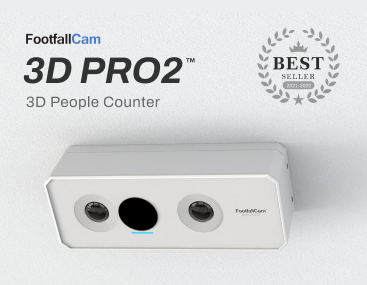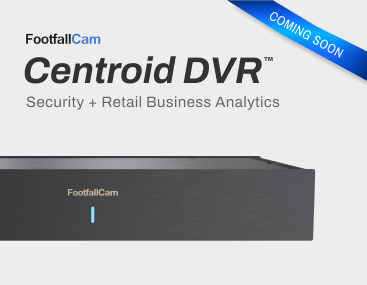Glossary / Definition of Terms
Find out moreWhat are the definitions of these glossary terms within the context of people counting systems?
Accuracy
Accuracy: to characterise how well a device detects and counts targets in a variety of settings with fluctuating pedestrian traffic volumes, as well as how well bi-directional counters maintain a balance between "in" and "out" counts in the field of people counting.
Anonymise
Anonymise: to carry out a procedure such that privacy is maintained. a procedure that is frequently necessary when employing video-based counters to safeguard the identification of individuals entering a counting zone. The FootfallCam 3D people counters have this feature built-in.
Automatic visitor counter
Automatic visitor counter: a tool that eliminates the need to manually tally site visits. A visitor counter that is automated keeps track of and reports on the number of persons entering or exiting a location.
BACnet
Building Automation and Control Networks (BACnet): an ISO standard for connecting BMS devices and controllers via a BMS-specific network. This makes it possible to assess HVAC consumption and realise significant efficiency gains by centrally controlling and monitoring HVAC.
Bi-directional footfall
Bi-directional footfall: the capability of a people counting device to tally individuals moving in both directions.
Building Energy Management: aids commercial enterprises in decreasing carbon emissions and energy consumption. These solutions regulate and oversee HVAC (Heating, Ventilation, and Air Conditioning) systems, and frequently include lighting control as well. By employing people counters and schedules to monitor both current and projected space utilisation, we can integrate these counters with HVAC systems to enhance efficiency. Consequently, it becomes feasible to illustrate energy consumption per individual rather than per square metre of commercial space.
Building Information Modelling (BIM): involves the incorporation of People Counting data alongside various other metrics to aid in the generation and management of digital representations detailing the physical and functional attributes of a facility. These models are shared to facilitate decision-making regarding a facility's lifecycle, spanning from initial conceptualisation, through design and construction, to its operational phases.
Building Management System (BMS): a computerised control system implemented in buildings to regulate and supervise mechanical and electrical equipment, including ventilation, lighting, power systems, fire systems, and security systems. They comprise of software and hardware controllers interconnected via a network, often using the BACnet protocol. People counting system can enhance the efficiency of a Building Management System by assisting in energy management through occupancy-based control of specific zones within the building.
Conversion Rate: the ratio of individuals passing by a store to individuals entering the store or the ratio of individuals making purchases to the total foot traffic within a specified timeframe.
Count Lines: the lines set up around an entrance or exit, designed to optimise the duration for tracking by thermal or video people counters. The objective is to extend tracking time while reducing inaccuracies caused by objects, merchandise, or customer movements within the counting area.
Counting Zone: the particular region observed by a footfall counter or the overall area encompassed by footfall counters spanning each pedestrian entrance.
Conversion Rate: the ratio of individuals passing by a store to individuals entering the store or the ratio of individuals making purchases to the total foot traffic within a specified timeframe.
Customer Counter: a tool used to monitor the number of customers visiting a business. The data obtained from this device can grasp conversion rates and inform business decisions.
Customer Counting: using people counting technology as a way to track the number of visitors they attract.
Customer insight: involves gathering, utilising, and analysing data that enables a business to attract, nurture, comprehend, and retain its customer base. Footfall data provides crucial insights for businesses to gain deeper understanding into customer behaviour.
Customer traffic: commonly known as customer flow, denotes the number of customers who visit a retail store.
Desk Sensors: PiR sensors positioned on or near workplace to monitor occupancy and gather usage data.
Dwell Time: the duration an individual remains within a particular area. Bi-directional footfall counts and calculations based on the mean occupancy within a specified timeframe can be used to calculate average dwell time. Employing customer tracking technology allows for more detailed analysis of dwell time for individual visitors.
Electronic People Counter: an electronic equipment that detects and counts the number of people entering or exiting a location. There are various methods, such as break beam systems, thermal signature recognition and 3D video technology.
Event Counting: tracking the number of visitors at an event, aiming to assess interest in the event, or to aid in health and safety measures and crowd management.
Event Management: an organised planning, preparation, and supervision of various elements that can influence an event and the behaviour of the crowd. Effective event management involves evaluating the capacity of a venue to handle visitors beforehand. This involves assessing projected and actual crowd sizes, providing clear signage indicating entry and exit points, ensuring adequate staffing levels, and establishing well-defined and communicated emergency evacuation protocols.
Event Occupancy: the number of visitors present at an event, which may span across multiple buildings or areas. Additionally, it may also refer to the projected maximum capacity of visitors who can attend an event, commonly used for event planning.
Flow accuracy: the accuracy of counting foot traffic moving in a single direction by a people counter.
Footfall: the number of people entering a shop, business, site, or space within a specific timeframe. It serves as a significant metric for assessing the effectiveness of a company's advertising efforts in attracting people to its establishments.
Flow accuracy: the accuracy of counting foot traffic moving in a single direction by a people counter.
Footfall Counter: An electronic device used to quantify foot traffic, which is the number of people entering and exiting a location. There are various methods, such as break beam systems, thermal detection, and video detection.
Footfall Reporting: The data generated by footfall counting devices, formatted into actionable information to aid in making business decisions.
Free Flow Event: an event where the fans can move between different zones freely, which may potentially lead to overcrowding. Employing people counters to monitor visitor flow rates can assist in forecasting when a zone is likely to reach maximum occupancy. This helps the event control team implement flow management measures pre-emptively, preventing overcrowding.
Frequency: the rate at which a room or space is used within a specific timeframe.
Group Counting: a sophisticated people counting algorithm capable of determining the potential relationships among visitors by analysing their proximity to each other and the trajectory they follow through the counting zone.
Increase Retail Conversion Rate: A common goal for retailers aiming to enhance their sales performance. Achieving this can involve strategies such as driving more foot traffic into the store, increasing the average purchase size of each customer, or ensuring that customers receive excellent customer service, thereby encouraging them to make a purchase. Increasing the retail conversion rate means maximising the number of sales per potential customer who enters the store. Even a slight improvement in the retail conversion rate can yield significant benefits for the overall profitability of the business.
Live Event Occupancy: the current number of visitors present at an event at a specific moment in time. Automated people counting systems enable organisations to monitor their live event occupancy in real-time throughout the day.
Live Occupancy Counting: using electronic people counters to gain real-time occupancy and visitor flow rate displays, presenting data within 10 seconds of visitors passing through a counting zone.
Live People Counting: counting people as they enter or exit a certain area and providing this data to the end user in real-time.
Live People Counting: using people counting technology to generate nearly real-time data on foot traffic.
Marketing Performance Measurement and Management (MPM): a term used by marketing professionals to describe the assessment and enhancement of the efficiency and effectiveness of marketing efforts. This involves aligning marketing activities, strategies, and metrics with business objectives. It includes establishing a metrics framework to monitor marketing performance, and employing marketing dashboards to manage it. The focus is on evaluating, overseeing, and analysing marketing performance to maximise effectiveness and optimise return on investment (ROI). Data, analytics, and metrics are crucial elements in managing marketing performance. While brand recognition may be a part of marketing objectives, for retailers, an increase in sales and profits serves as the primary ROI indicator. However, solely an increase in sales transactions does not provide a comprehensive view of a marketing campaign's effectiveness. For instance, if sales transactions rise by 10% while store footfall increases by 100%, it indicates high campaign effectiveness, but other factors may diminish potential ROI. Hence, incorporating footfall metrics from people counters into MPM is essential for understanding the true effectiveness of a marketing campaign.
Missed Opportunities: potential customers who visit a store but leave without making a purchase due to many reasons, such as long queue lengths or wait times, insufficient staff availability, pricing, or product availability issues.
Occupancy: the total number of people in an area. It is calculated by subtracting the total number of 'out' counts from the total number of 'in' counts at any given time. Alternatively, it can be determined using FootfallCam people counting technology, which can analyse the total number of people within the detection range of the counter.
Occupancy Accuracy: achieved by using overhead counters with precise and consistent flow-rate accuracy. However, achieving this accuracy can be challenging due to inherent slight inaccuracies present in all existing people counting technologies. These inaccuracies can accumulate, especially in scenarios with low maximum capacities, short average dwell times, high footfall, and high-volume traffic flow rates. To address this, FootfallCam diligently monitors counter accuracy under various conditions and adjusts the relevant factors for 'in' or 'out' counts to mitigate potential errors. This ensures a balanced approach and enables clients to understand the expected tolerance of the system, thus facilitating decision-making based on reliable data.
Occupancy Management: leveraging data obtained from visual sources, CCTV, and people counting equipment to aid decision-making and implement procedures aimed at regulating visitor flow and maintaining occupancy levels of venues with predetermined maximum capacities.
Occupancy Tracking: tracking the number of people present in a building, space, or area, and monitoring how this quantity fluctuates over time.
Occupant-Centric Scenario Modelling for Energy Management: using FootfallCam People Counting 'Smart Building' Space Management solutions enables businesses to grasp energy usage in buildings on a per person basis rather than per square metre
Office Space Management: implementing systems to enhance the efficient utilisation of desks and meeting rooms within office premises. Strategies such as Hot-desking and Hoteling are employed to optimise the ratio of staff to desks. FootfallCam offers desk sensors capable of monitoring desk utilisation by tracking activity at individual desks, within departments, or across building floors.
Over-counting: occurs when the people counters count a higher number of people than the actual count. This may be due to the factors such as environmental conditions, inadequate configuration, unforeseen staff, or customer behaviour within the counting zone.
Passing Traffic: the number of people walking past a particular site. For instance, for a retail store situated on a high street, passing traffic includes pedestrians passing by the front of the store on the street outside. Traditional automated people counting methods, such as beam or overhead counters, find it challenging to measure passing traffic accurately. However, passing traffic can be quantified using Wi-Fi tracking technology installed in the store. This technology anonymously tracks the signals emitted from mobile devices and distinguishes, based on signal strength, whether they are within the store or passing by on the street outside.
People Counter: an electronic device designed to detect and count the number of people.
People Counting: the process of collecting footfall data on visitors and customers.
People Counting Software: a program that aggregates data from people counting devices to generate footfall data reports.
Power over Ethernet (PoE): a technology that enables the transmission of electrical power, along with data, safely over CAT5 or CAT6 Ethernet cabling, which FootfallCam 3D Pro2 supports it.
Real-Time Counting: the capability of counting and showing live footfall or occupancy counts within 5 seconds of the target passing through a count-zone.
Refining Operating Hours: analysing customer traffic and sales transactions in comparison to staffing expenses and other expenses related to maintaining site operations. This analysis helps determine profitable times for keeping a site open and when it is preferable to close due to limited customer potential. Evaluating footfall and passing traffic provides a more accurate measure for setting opening hours and maximising sales.
Remote Monitoring: a service provided by FootfallCam aimed at ensuring that our clients' people counters are connected to the network and operating properly. This service automatically detects any connectivity issues and can identify specific accuracy issues. Additionally, remote access to people counters allows FootfallCam engineers to log in and inspect the view of the counting zone, enabling manual assessment of counter accuracy.
Retail Footfall: the number of potential customers in a retail environment. It can be used to compare with sales figures to calculate conversion rates.
Retail Footfall Index: a comparison of footfall statistics gathered from various sites across a country.
Retail Metrics: the data that can be analysed and synthesised to provide a better understand into customer behaviour, marketing effectiveness, and store and staff performance. Footfall data serves as a vital metric in assisting retailers in comprehending their business's strengths and areas for improvement.
Sales Conversion (ratio): the ratio of visitors to a retail store who actually make a purchase to the ratio of total amount of visitors to a retail store.
Shopper Tracking: the ability to track the paths taken by individual customers or creating a heat map that illustrates the most frequented paths within a retail environment and the primary areas of interest where customers spend significant time browsing.
Staff Planning: the process of planning the staff composition to meet business objectives and provide a high level of customer service to maximise sales conversion rates in retail and customer satisfaction in service industries. The footfall data can be used to forecast peaks and troughs in customer numbers, enabling businesses to minimise staff expenses during low footfall periods and optimise customer service and profitability during high footfall periods, where inadequate staffing might otherwise compromise customer service.
Stereoscopic: utilises two lenses to enable the creation of three-dimensional vision, resulting in images with depth and shape. Stereoscopic video counters, such as FootfallCam 3D Pro2, leverage this capability to achieve more precise people counting.
Time of Flight Footfall Counter: These counters emit infrared light pulses. By measuring the slight variations in the time it takes for the light to return to the counter after bouncing off surfaces, devices like the FootfallCam 3D Mini can construct a highly precise distance map of the area below.
Traffic Density: the number of people passing through a specific area under a people counter at any given time.
Traffic Patterns: the historical highs and lows in footfall rates.
Under-counting: occurs when the people counters count a fewer number of people than the actual count. This is a weakness when Beam Counters are deployed across a broad entrance. However, both thermal and video counters can also experience under-counting, especially when there is high level of traffic density. Consistent under-counting can be addressed by applying a correction factor to each set of counts, such as adding 10% to the daily footfall count.
University Space Management: a system used by FootfallCam that utilises various people counting technologies installed in classrooms and other significant student areas within universities. Its purpose is to collect data on occupancy and usage rate, and to calculate precise space utilisation data.
Utilisation: the measurement of how effectively a space is being used. It involves analysing the average occupancy of a room and how frequently the room is utilised.
Velocity Filter: an algorithm in people counting systems that identifies and filters targets based on their speed of movement through the counting zone.
Venue Occupancy: the maximum number of people that a venue can accommodate.
Footfall: the number of people entering a shop, business, site, or space within a specific timeframe. It serves as a significant metric for assessing the effectiveness of a company's advertising efforts in attracting people to its establishments.
Video Counting: using video technology to count people or objects. Systems based on CCTV typically incorporate supplementary software features with background processing, susceptible to environmental influences, often leading to inconsistent or inaccurate counts. More specialised video counters employ onboard processing, delivering improved accuracy. Nonetheless, the majority of single-lens video counters struggle to achieve desirable levels of accuracy or consistency.
Video Validation: a feature that enables the recording of a video stream alongside footfall data, allowing for the retrieval of video footage, stored count data, and diagnostic information through a single IP data stream. This feature is available on all FootfallCam 3D people counters, including the FootfallCam 3D Pro2 and FootfallCam 3D Extend models
Visitor Counter: a device specifically created to count the number of people entering or exiting a public venue.
Weather Effect: the impact that weather conditions have on footfall trends across different sites, depending on factors such as their purpose, inventory, and location. For example, footfall may increase on a rainy day at a sheltered shopping centre or stores selling umbrellas, but decrease for typical high street shops. The influence of weather on footfall varies depending on the nature and location of each site. By evaluating the impact of weather on footfall, managers can anticipate the quantitative traffic response and make appropriate staffing adjustments.
Workforce Management: the process of scheduling staff hours to maximise the utilisation of office space, particularly in environments employing hot-desking, flexible workspaces, and break-out areas. Alternatively, it can mean that scheduling staff to enhance sales conversion in a retail environment.
Workspace Management: using people counters to gain peaks and troughs in office occupancy throughout each day, week, and month, illustrating the percentage use of an office space compared to its designated capacity to aid in managing office spaces. Traditionally, office space management analysis relies on anecdotal evidence or manual counts, which are labour-intensive and offer only a snapshot of actual usage levels. Given the high cost associated with running a single office workstation, many organisations seek to consolidate space. People counters offer an objective, consistent, and comprehensive overview over time, providing reliable data for managing desk space and informing business decisions regarding the consolidation or expansion of premises efficiently.
The Pioneer in People Counting Analytics
Founded in the UK in 2002, we've become the leading global provider of people counting solutions. Proudly an engineering firm, we specialise in utilising state-of-the-art technologies to create reliable, accurate, and useful people counting products.















